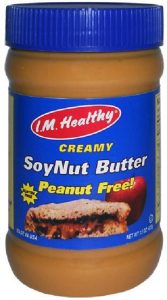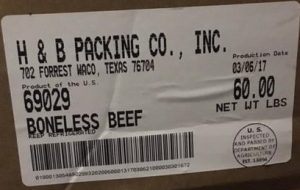And who produces this shit that someone slaps a label on? According to legal eagle Bill Marler, it’s Dixie Dew Soy Nut Butter.
 What follows is a joint composition, like Lennon and McCartney, Jagger and Richards, except we can’t figure out how to post it appropriately, and despite years of asking journalists to make us look cool, we recognize our role in life (hockey coaches).
What follows is a joint composition, like Lennon and McCartney, Jagger and Richards, except we can’t figure out how to post it appropriately, and despite years of asking journalists to make us look cool, we recognize our role in life (hockey coaches).
And since there will be no royalties to haggle over, it’s not a concern.
In 2007, CDC foodborne illness outbreak guru Rob Tauxe told a group of food safety folks that the next big thing for food safety was low-moisture ingredients.
Salmonella is hardy, especially when stressed through drying, so it sticks around for a while in dry ingredients.
The comments were post-Salmonella Tennessee in Peter Pan peanut butter and pre-Salmonella Wandsworth in Veggie Booty (and other outbreaks) and he talked about dried spices and flavorings and peanut butter-type products like hummus and tahini.
Since Rob’s talk, the food safety community has seen lots of Salmonella in low- moisture foods like nuts, spices, chia seed powder and food grade lime stone
Not a food, but the pathogen has even been shown to persist in playground sand.
There’s been Listeria in hummus and pathogenic E. coli in flour, cookie dough and now soy nut butter (which sounds pornographic).
I.M. Healthy, one of the most ironic product names in the history of food, has been linked to at least 23 E. coli O157 illnesses (including 8 hospitalizations) in nine U.S states.
The good public health folks in Oregon found the outbreak strain in a sample of soy nut butter taken in one of the victim’s homes.
According to CDC, in interviews, ill people or their family members answered questions about the foods they ate and other exposures in the week before they became ill.
In 2009 when PCA was distributing Salmonella-contaminated peanut paste products to lots of manufacturers, lots of folks were asking questions about how the pathogen survived in the low-moisture environment and whether the outbreak was an indicator that the snack food industry was facing a larger issue. Since then there have been numerous low-moisture food outbreaks (here’s a review from Sofia Santillana Farakos and Joe Franks).
Friends of barfblog Larry Beuchat and Scott Burnett did some of the early work on peanut and Salmonella following an outbreak in Australia and showed that the pathogen could survive for a long, long time:
Post-process contamination of peanut butter and spreads with Salmonella may to result in survival in these products for the duration of their shelf life at 5 degrees C and possibly 21 degrees C, depending on the formulation.’
The almond industry, partnering with the Almond Queen, and friend of barfblog, Linda Harris led the way addressing this issue about a decade ago. After numerous studies examining Salmonella survival, movement, transfer, persistence and destruction they’ve implemented a kill-step in their process. The peanut industry, in the wake of two outbreaks followed.
What will the soy nut folks do?
As the outbreak investigation unfolds, and the lawsuits pop up, lots of questions remain:
How much contamination was there (10 cfu/g? 1,000,000 cfu/g)?
Was it co-packed?
Did they have a sanitation clean break between lots?
Why was I.M. Healthy so specific about the recalled lots initially, and then expanded the recall? Did FDA investigators feel the procedures weren’t effective?
Have they validated their sanitation procedures?
How well did the sanitation crew do their job?
Twenty-three people infected with the outbreak strains of STEC O157:H7 have been reported from nine states. A list of the states and the number of cases in each can be found on the Case Count Map page.
Illnesses started on dates ranging from January 4, 2017, to March 5, 2017. Ill people range in age from 1 to 48 years, with a median age of 8. Twenty (87%) of the 23 ill people are younger than 18 years. Among ill people, 61% are male. Ten ill people have been hospitalized and seven people developed hemolytic uremic syndrome (HUS), a type of kidney failure. No deaths have been reported.
Illnesses that occurred after February 24, 2017, might not yet be reported due to the time it takes between when a person becomes ill and when the illness is reported. This takes an average of 2 to 3 weeks.
In interviews, ill people or their family members answered questions about the foods they ate and other exposures in the week before they became ill. Twenty (87%) of the 23 people reached for interview reported either eating I.M. Healthy brand SoyNut Butter at home (14 people) in the week before they became ill, attending a facility that served I.M. Healthy brand SoyNut Butter (2 people), or attending childcare centers that served I.M. Healthy brand SoyNut Butter and I.M. Healthy brand granola coated with SoyNut Butter (4 people). SoyNut Butter is a nut-free substitute for peanut butter.
Investigators have reported to CDC two more ill people who either developed HUS or had a diagnostic test showing they were infected with STEC bacteria. In interviews, both of these ill people reported eating I.M. Healthy brand SoyNut Butter in the week before becoming ill. However, CDC is not including these people in the outbreak case count because no bacterial isolates, or samples, were available for DNA fingerprinting. Public health investigators use DNA fingerprinting to identify illnesses that are part of outbreaks.
Laboratory testing identified STEC O157:H7 in opened containers of I.M. Healthy brand SoyNut Butter collected from the homes of ill people in California, Oregon, and Washington. Officials in California also isolated STEC O157:H7 in unopened containers of I.M. Healthy brand SoyNut Butter collected from retail locations. Further testing using pulsed-field gel electrophoresis (PFGE) showed that the STEC O157:H7 in all of these containers of SoyNut Butter had the same DNA fingerprints as the STEC O157:H7 isolates from ill people.
The investigation is ongoing. CDC will update the public when more information becomes available.
Good rock and roll is straightforward, in your face. Bad recalls are slippery, slimey affairs, involving bureaurocratic fucks who can’t imagine life without a job rather than submitting a kid to lifelong kidney problems.
So on the 40th anniversary of AC/DC’s Let There be Rock, please, people, develop a public health spine.











